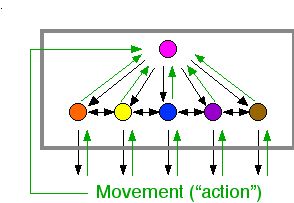 |
http://serendipstudio.org/localscisoc/leadership04.html/
| 
|
First Session
The Brain: Insights Into Individuals and Complex Organization
Starting where we are ...
For later posting in the on-line forum write down
- three sentences that you would use to introduce yourself (as a person/athlete) to someone whom you don't know/who doesn't know you
- three sentences that describe what you currently think are the most important things to understand about "leadership"
Background
From literature - Emily Dickinson
(1830-1886):
The Brain - is wider than the Sky -
For - put them side by side -
The one the other will contain
With ease - and You - beside-
|
| Brain (nervous system) = behavior
Athletes are brains
Teams are interacting brains
Makes sense to know something about brains ...
|
Thinking about "leadership" in light of the brain
- Hierarchical systems, in which one "leader" has a blueprint detailing the optimal performance of all team members and directs all team members in terms of that blueprint, do not exist in the brain. This is one among a number of reasons to suspect that such systems will not work well in most real life situations. Various forms of more distributed leadership characterize biological systems - the most successful forms of complex organization known - at all levels of scale from microbes to ecosystems.
- A "leader" may in some cases be any member of a team who shares with other members information about what they themselves are doing, and acts in ways that reflect what others are doing. "Leadership" can be diffuse across a team, and move without notice from one team member to another.
- In a team characterized by diversity, one in which individuals have different strengths/weaknesses, a "leader" may, like other team members, be "specialized". In this case, a "leader" is not a "director" who tells other team members what to do. but is instead someone who has a distinctive ability to monitor the performance of most or all other team members and relate individual performance to group performance. Their role is to facilitate information flow among team members with the addition of information and suggestions based on overall group performance. "Leadership" of this kind has some architectual similarities to that in hierarchical systems but is profoundly different in important ways. Because of the bidirectional information flows, the group objective is no more that of the "leader" than in it is of any other member of the team. The "leader" should be respected for what she distinctively contributes, just as any other team member, and should have no more "status" than any other team member. Perhaps the term "leader" should be redefined as "integrator" or "synthesizer".
- Each of the leadership models is likely to have different strengths and weaknesses in different contexts but the lack of successful hierarchical models in biological systems seems quite significant.
For further exploration:
REMEMBER to leave your thoughts in the on-line forum area for others ....
Note added after session
Diversity provides an important driving force for exploration. Perhaps the organization expressed in the complex brain is the optimal one for amplifying the exploratory process, by making possible effective groups of diverse individuals?
Home
| Calendar | About
| Getting Involved
| Groups | Initiatives | Bryn Mawr Home | Serendip Home
Director: Liz McCormack -
emccorma@brynmawr.edu
| Faculty Steering Committee
| Secretary: Lisa Kolonay
© 1994-
, by Center for Science in Society, Bryn Mawr College and Serendip
Last Modified:
Wednesday, 02-May-2018 11:57:04 CDT






